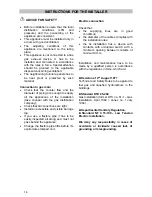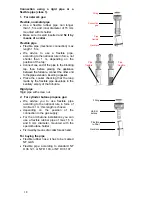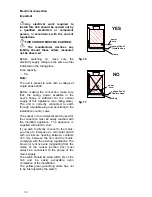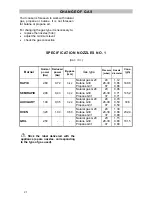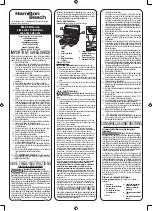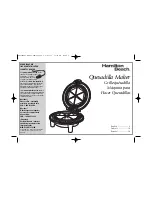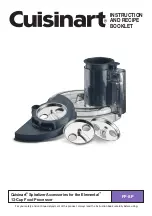
16
INSTRUCTIONS FOR THE INSTALLER
ADVICE FOR SAFETY
•
Before installation ensure that the local
distribution conditions (LPG and
pressure) and the pre-setting of the
appliance are consistent;
•
This appliance must be installed only in
a room with good ventilation;
•
The adjusting conditions of this
appliance are mentioned on the rating
plate;
•
This appliance is not connected to a flue
gas exhaust device. It has to be
installed and connected in accordance
with the rules in force. Special attention
should be granted to the applicable
disposal concerning ventilation;
•
The neighbouring furniture panels has to
be heat proof or protected by such
material.
Connection to gas main
•
Check that the counter flow and the
diameter of piping are enough to supply
all the appliances of the installation
(take counsel with the gas distribution
company);
•
Check that all connections are tight;
•
Install an accessible and visible barrage
tap;
•
If you use a flexible pipe it has to be
easily inspected all along and must not
pass behind the appliance;
•
Change the flexible pipe little before it’s
expire date stamped on it.
Electric connection
Check that:
•
the supplying lines are in good
conditions;
•
the diameter of the cables complies with
the installation rules;
•
the fix installation has a device with
contacts with omnipolar switch with a
minimum opening between contacts of
minimum3 mm.
Installation and maintenance have to be
made by a qualified person in accordance
with the regulations in force, which are:
Decision of 2
nd
August 1977
Technical and Safety Rules to be applied to
fuel gas and liquefied hydrocarburs in the
buildings.
Standard DTU 45-204
Gas Installation (former DTU no. 61-1 – Gas
Installation, April 1982 + annex no. 1 July
1984).
Departmental Sanitary Regulation.
Standard NF C 15-100 – Low Tension
Electric Installation.
We deny any responsibility in cases of
accidents or incidents caused lack of
grounding or missgrounding.















